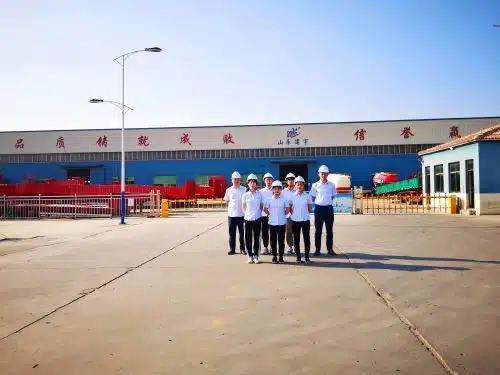Cement Tanker
Home » Cement Tanker
Genron’s line of cement tankers includes the 30CBM, 35CBM, 40CBM and 45CBM models. These tankers are designed for superior efficiency, safety, and durability. They excel at transporting a wide range of materials, including cement, lime powder, and mineral powders. Their design prioritises ease of loading and unloading. It also minimises residue and ensures safe transport.
bulk cement trailer For Sale
Key Features and Benefits
Efficient Material Transport: Transport large volumes of bulk materials seamlessly. The Genron dry bulk pneumatic trailers are engineered to handle cement, lime powder, sand, and other materials, reducing total transport time and improving operational efficiency.
Pneumatic Unloading System: The integrated pneumatic system ensures quick, safe, and efficient unloading. Keep your materials dry and clean, protected from external contaminants while reducing residue.
Durable Construction: Manufactured using top-tier materials, the tanker features a robust design to handle intense and demanding work environments. This means long-lasting performance and reduced maintenance costs over time.
Customizable Options: Tailored to meet specific operational needs, sizes ranging from 30CBM to 45CBM and specialized configurations such as funnel, elevated, horizontal, V-type, Euro type, and tipping type are available for unique applications.
Enhanced Safety Features: Vacuum-sealed storage protects your materials against moisture and airborne contaminants, ensuring they maintain their quality from loading to unloading.
Cost & Time Savings: With pneumatic loading and unloading, save both labor costs and valuable time. Its advanced design minimizes material loss and optimizes transport cycles.
Versatile Applications: Ideal not just for the construction industry but also for agriculture as a slurry tanker and for other industrial applications requiring high-grade bulk transport solutions.
Comprehensive Suspension and Axle Configurations: Choose from air ride suspension, mechanical leaf spring suspension, or bogie-type suspension to ensure smooth rides, along with multiple axle configurations for enhanced stability and load distribution.
Optional Advanced Components: Available with electrical or Deutz diesel engine compressors for even greater customization and convenience, adapting to your operational preferences.
Why Choose GENRON dry bulk tanks?
When businesses face high demands and tight deadlines, Genron stands out as a reliable ally. Known for our durability, precision manufacturing, and attention to detail, we’ve built a reputation for delivering equipment that resolves pain points while optimizing performance. With the Genron Cement Tanker, you are investing in efficiency, safety, and superior quality that drives long-term success.

/01 Unmatched Durability
Face the toughest jobs head-on with confidence. Our semi-trailers are made with Q690 high-strength steel and top-notch engineering. They perform well in harsh environments, from mining sites to industrial transport. This means less maintenance and longer life for your trailers, keeping your operations smooth.

/02 Tailored Solutions
GENRON understands your unique transport challenges. We offer customized solutions, from FUWA or BPW axles to adjustable main beam heights. You can even choose hydraulic steering for oversized cargo. Get a trailer that boosts your efficiency.

/03 Expert After-Sales Support
GENRON's support doesn't end when you buy. Our team of experts is here for you, offering maintenance tips and technical help. This ensures your semi-trailer runs at its best. For logistics and construction suppliers, our service cuts downtime and boosts productivity.
Applications
The Genron Cement Tanker is versatile and reliable, making it ideal for various industries, such as:
Construction – Optimized cement and material delivery for large-scale building projects.
Agriculture – Functions as a slurry tanker, providing dependable support for agricultural needs.
Industrial Operations – Efficiently transports bulk powders for manufacturing plants and factories.
Logistics – Streamlines delivery of bulk materials, meeting tight deadlines and maximizing productivity.
Customization Options
At Genron, we understand that every operation has specific needs. That’s why we offer customizable sizes and configurations, including:
30CBM, 35CBM, 40CBM, 45CBM volumes
Configurations like funnel, elevated, horizontal, and V-type
Suspension types tailored for stability and durability under varying loads
Color options to match your brand preferences
Request a Quote Today!
Genron dry bulk tanker are built to perform and stay ahead of the curve. High-strength materials and vacuum-sealed storage technology enhance transportation safety, while rugged design ensures years of reliable operation. The tankers feature best-in-class safety measures and industry standards to reduce risk to operators and transported materials.
Reliable bulk transportation is critical to your operations, so don’t compromise. Experience the performance of a Genron cement tanker today.
Contact us today for a quote or speak to one of our experts to tailor a tanker to your unique needs. Choose Genron for consistent deliveries, increased productivity, and peace of mind.
Let’s Build Something Great, Together
FAQ
We offer flexible payment terms, which include T/T (Telegraphic Transfer) and L/C (Letter of Credit). For detailed information, feel free to contact our sales team directly.
You can contact us via email at service@genronvehicle.com to request a quote or place an order. Our team is ready to assist you every step of the way.
Absolutely. Our Cement Tankers come with a comprehensive warranty and after-sales support to ensure hassle-free operations and customer satisfaction. Any technical concerns or maintenance needs will be promptly attended to by our team.
You should do regular maintenance. Do it according to the manufacturer’s schedule. You should do it after each trip. This keeps the vehicle safe and efficient. Certain components, such as air filters, may need to be inspected and replaced more frequently.
Cement tankers are fluidized using compressed air. This turns the cement into a fluid for unloading. The air passes through the fluidized bed. This reduces friction and lets the cement flow freely.
The typical lead time is 30-45 days from the confirmation of your order, depending on the specifications and customization required. Our team will provide you with an estimated timeline upon order placement.
Yes, Genron offers customization options to meet your specific operational needs. Our specialists will work with you to tailor the design, capacity, and features of the tanker to fit your requirements.
Yes, cement tankers can also carry other fine powders such as lime, sand, and certain granules. But, the materials must match the tanker’s design, and cleaning protocols must prevent cross-contamination.

